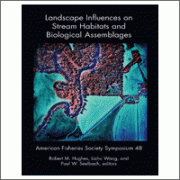Using a Landscape Approach to Identify the Distribution and Density Patterns of Salmonids in Lake Ontario Tributaries
AUTHOR(S): Les W. Stanfield, Scott F. Gibson, Jason A. Borwick
CITATION:
Stanfield, L.W., S.F. Gibson and J.A. Borwick. 2006. Using a landscape approach to identify the distribution and density patterns of salmonids in Lake Ontario tributaries. In: Landscape influences on stream habitats and biological assemblages, American Fisheries Society, Madison, WI. 48: 601-621. https://doi.org/10.47886/9781888569766.ch29
ABSTRACT:
Effective management of salmonid populations in the Great Lakes basin requires understanding how their distribution and density vary spatially. We used a hierarchical approach to evaluate the predictive capabilities of landscape conditions, local habitat features, and potential effects from coinhabiting salmonids on the distribution and densities of Rainbow Trout Oncorhynchus mykiss, Brook Trout Salvelinus fontinalis, Brown Trout Salmo trutta, and Coho Salmon O. kisutch within the majority of the Canadian tributaries of Lake Ontario.
We collected fish assemblage, instream habitat, and water temperature data from 416 wadeable stream sites. Landscape characteristics were obtained for each site’s catchment and summarized into six key attributes (drainage area, base flow index, percent impervious cover (PIC), reach slope, elevation, and location with respect to permanent fish barriers). Classification trees indicated that PIC in a catchment was a critical predictor of salmonid distribution, in that beyond a threshold of 6.6–9 PIC, all salmonids were predicted to be absent. Base flow index and barriers were also important predictors of the distribution of salmonids. Models generally provided higher classification success at predicting absence (86–98%) than predicting presence (63–87%). Landscape features were the best predictors of densities of Rainbow and Brook Trout (adjusted r2 = 0.49 and 0.30 respectively), although the local habitat features were almost as effective for predicting brook trout (r2 = 0.23). Local habitat features (proportion of riffles and pools, substrate, cover, and stream temperature), and presence of other salmonids produced the best predictive model for Brown Trout. Coho Salmon was only locally distributed in the basin, and the derived model was driven by spatial characteristics rather than ecological processes. Our models estimate 653,000 juvenile Rainbow Trout and 231,000 Brook Trout (all age-classes) in our study streams. Finally, we estimate that current Brook Trout distribution in our study area is only 21% of its historic range.
FULL TEXT – Stanfield et al.



